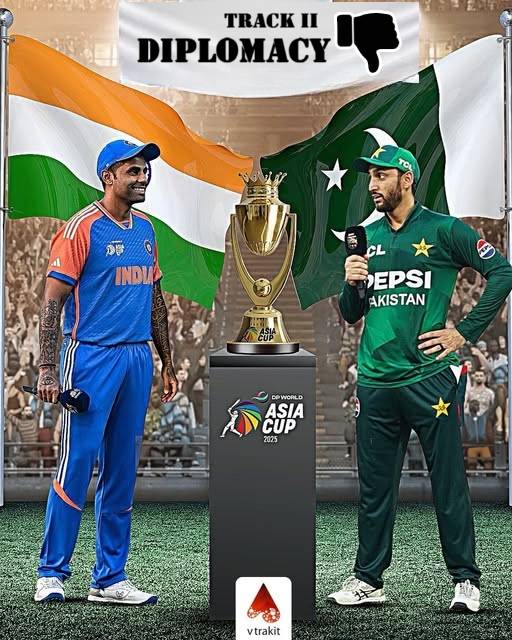
- Without trust, cooperation, and strategic discipline, even shared cultural passions like cricket cannot serve as a bridge during politically charged times.
- The Asia Cup 2025 highlighted the realisation of how the game of cricket, which has long been a cornerstone of diplomacy between two neighbours, has turned into a battleground.
- Cricket has served as a means for countries to engage during difficult bilateral times in formal diplomacy, but it has also been a platform for provocation and defending positions.
- Asia Cup 2025 serves as a stark reminder that even diplomacy thrives on shared commitment, focus, and vision, though these may often remain beneath the surface.
Cricket has always been more than just a game between India and Pakistan; it carries the weight of history, culture, and diplomacy. Small actions, like a handshake after a match, are charged with significant symbolic meaning, acting as a shorthand for mutual respect, trust, and even reconciliation. This customary norm is dated and linked to Ancient Greece in the 5th century B.C., where it expressed peace and goodwill. Even today, these simple gestures carry deeply embedded meaning. In South Asia, where cricket is a passion that borders on religion, such actions mean everything. A simple handshake on the field can be a powerful message of goodwill, just as its absence can highlight the tensions that the game embodies. In rivalry games, these small moments can have as much impact as the runs scored.
Throughout history, cricket has often broken the ice when official diplomacy has stalled. In 1987, at the height of the ‘Brasstacks‘ military crisis, the situation was severe, with almost 400,000 soldiers from the Indian Army participating in the largest military exercises since World War II. Pakistan’s General Zia eased tensions by visiting India for a cricket match and a meeting. It was a brilliant political gambit disguised as a sporting outing. In 2011, the script played out again: the World Cup semi-final in Mohali brought Indian and Pakistani leaders onto the field. India’s invitation and facilitation turned a sporting contest into a stage for informal diplomacy, a rare demonstration of India taking the initiative to maintain engagement.
In both cases, the game provided neutral ground for leaders to connect. Here, India’s invitation and facilitation turned a sporting event into a platform for informal diplomacy, a rare example of India taking the lead to sustain interaction. These moments are classic examples of Track II diplomacy in action, where informal interactions create a vital space for dialogue and build crucial understanding, especially when political deadlock makes official conversation impossible.
Asia Cup 2025: A Diplomatic Freeze
The Asia Cup 2025 highlighted the realisation of how the game of gentlemen’s cricket, which has long been a cornerstone of diplomacy between two South Asian neighbours, has turned into a battleground. Although India won by six runs, it didn’t feel like a real victory. Instead of meeting in the middle, as is customary when a match ends, the players simply left without a handshake. The audience went quiet. That silent earthquake of a handshake was instantaneous in our digital world. It turned out to be the true tale, a connection broken rather than a game won.
There is a bitter background to this moment. The ghost of Pulwama, an attack that prompted Operation Sindoor, India’s retaliation to the dastardly terror attack in Pahalgam, and border skirmishes, has undermined trust. Politics has become inexorably personal. The missing handshake is the consequence. This small ritual, meant for closure, now screams of division. At that moment, the two nations’ characters were clear. Pakistan’s objections were vocal and public. India’s response was its silence, a quiet, collective act that wasn’t an absence of feeling but a demonstration of a specific national discipline: a choice to speak through action, or in this case, through a pointed and purposeful lack of it.
Once a symbol of hope, cricket between India and Pakistan now mirrors mistrust. The absence of a handshake at Asia Cup 2025 spoke louder than words, showing how even sport’s simplest rituals can unravel under political strain.
The Weight of a Handshake
It has long been known that cricket is a medium in which seemingly insignificant rituals have deep meaning. Players and spectators have long been reminded by the MCC’s Spirit of Cricket that the fundamental elements of the game are fairness, respect, and acknowledgement of one’s opponent. These modest customs have developed into classic symbols of sportsmanship over time. When Richie Benaud and Frank Worrell shook hands following the first-ever tied Test in 1960, it was one of the most potent examples. That one handshake was about more than just cricket; it was about respect that transcended rivalry, history, and race. Brett Lee and Andrew Flintoff showed mutual respect during the 2005 Ashes, demonstrating that sportsmanship and fierce competition can coexist.
The Asia Cup 2025 has shown the world the eroding nature of this rich and historical tradition. Reflecting on the past, cricket has often served as a means for countries and people to engage during difficult bilateral times in formal diplomacy. However, at the same time, it has also been a platform for provocation and defending positions.
Pakistan’s team allowed domestic political issues to be reflected both on and off the field, as seen in their behaviour, including gestures of protest and defiance, time and again. In contrast, Indian players displayed a more mature attitude, restraining themselves from the effects of provocations directed towards them. The display made it very visible that the absence of symbolic gentlemanly sportsmanship, once part of cricket’s public ethos, was further magnified by narratives and comments on social media and the new viral forms of journalism.
Sports and Soft Power
ports have frequently served as diplomatic engines on a global scale, but only when conducted with discipline, strategy, and respect for one another. The 1971 table tennis exchanges between the United States and China, sometimes known as Ping Pong Diplomacy, opened the ground for Nixon’s historic visit to Beijing. Nelson Mandela’s use of rugby in 1995 helped unite a newly independent nation around common sporting aims. Similarly, cricket in South Asia has historically served as a bridge between India and Pakistan during times of political turmoil.
The erosion of these well-established norms in the 2025 Asia Cup offers deeper critical insights. Hyper-politicisation transforms sport from a neutral space into an arena for signalling, reducing the potential for informal diplomacy. Gestures sometimes regarded as unimportant take on additional significance in high-stakes matches, particularly in a region defined by history and political tensions. Without discipline, even longstanding rituals like post-match handshakes can become flashpoints for controversy, fines, and international scrutiny. Symbolic interactions on the field are inseparable from broader diplomatic contexts, especially in India-Pakistan relations.
Why Symbolism Still Matters
Looking ahead, restoring the potential of cricket as a vehicle for Track II diplomacy requires deliberate effort. Both countries must approach sporting events with discipline, respect for one another, and a strategic outlook. To retain their diplomatic value, symbolic behaviours such as handshakes and recognition gestures must be intentionally maintained. To the extent that cricket, widely watched and followed globally, continues to be interpreted through the prism of domestic political gains and never-ending rivalries, it risks depreciating this rare platform for people-to-people engagement and undermining its potential to pave the way for much-needed informal dialogues.
The Asia Cup 2025 serves as a cautionary tale. A brief, normative gesture like the handshake can capture the greater relationship between nuclear-armed neighbours. Its absence, exacerbated by media scrutiny and internet glorification of the act, represented more than just the loss of sportsmanship. It was a reflection of something much bigger than a game, the erosion of trust, the shutting down of informal channels where dialogue once flowed, and the fragility of traditions that once bound communities together. In the subcontinent, where every gesture, or lack thereof, carries weight well beyond the boundaries, cricket, which once provided infrequent moments of reconciliation, now serves as a mirror to the uneasy dance between symbolism and politics. India’s unwavering discipline and sportsmanship continue to be a strength even when symbolic gestures fall short.
Last but not least, what unfolded in the Asia Cup 2025 serves as a stark reminder that even diplomacy thrives on shared commitment, focus, and vision, though these may often remain beneath the surface. This is especially true when we speak of Track II diplomacy, which embodies the notion of informal diplomatic engagement.
Cricket, a game watched and revered from the Karakoram Range to the Sundarbans, extends far beyond the subcontinent, reaching major countries across the world. It holds an undisputed and often subtle power to unite people and emerges as an effective tool of soft power. However, to be mindful, such acts of natural bridge-building must be encouraged and respected, rather than politicised or dismissed for short-term domestic gains. Even if brief, the handshake is still a microcosm of potential. Its absence during this tournament highlights a sad reality: without trust, cooperation, and strategic discipline, even shared cultural passions like cricket cannot serve as a bridge during politically charged times.
Kabindra Sharma is a PhD scholar in the Department of Peace and Conflict Studies and Management, Sikkim University. Dr. Rippy Das is currently engaged as a Research Associate at the Centre for Russian and Central Asian Studies, Jawaharlal Nehru University (JNU). Views expressed are the author’s own.
